You can listen to Hoosier History Live! live on the air each Saturday, or listen online at the WICR website during the broadcast on any computer with speakers, anywhere, or on a smartphone. We invite you to visit our website!
Dec. 10 show
Holiday seasons with Indiana's only First Family
Television viewers have been treated to peeks at the White House during the holiday seasons of modern presidential administrations. What went on, though, during yuletide when the White House was occupied by the family of the only U.S. president elected from Indiana?
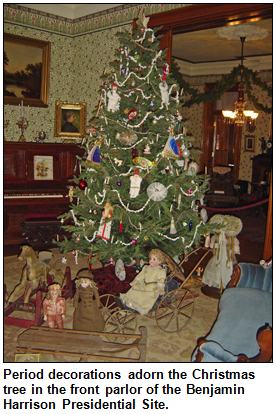 In the late 1880s and early 1890s, Benjamin Harrison and his wife, Caroline Scott Harrison, were in residence along with, periodically, their grown children and grandchildren.
In the late 1880s and early 1890s, Benjamin Harrison and his wife, Caroline Scott Harrison, were in residence along with, periodically, their grown children and grandchildren.
Did you know the Harrisons were the first "First Family" to have a decorated Christmas tree in the White House? The Harrisons also were the first to enjoy the new invention of electricity in the White House.
To explore how the holidays were celebrated there - and also at the Harrisons' home in Indianapolis, which now is known as the Benjamin Harrison Presidential Site - Nelson will be joined in studio by Jennifer Capps, the curator of the site at 1230 N. Delaware St.
According to Jennifer, President Harrison (who, of course, had a natural beard) portrayed Santa Claus for his grandchildren at the White House in December 1891.
"We intend to make it a happy day at the White House," President Harrison wrote to a New York-based journalist. "I am an ardent believer in the duty we owe ourselves, as Christians, to make merry for children at Christmas time, and we shall have an old-fashioned Christmas tree for the grandchildren upstairs; I shall be their Santa Claus myself."
During his administration, a reporter counted the plants displayed in the East Room - and came up with a whopping total of 5,000, including 40 heads of poinsettias.
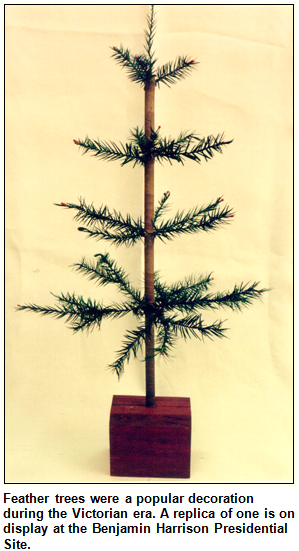 The Harrisons also were partial to feather trees, which, according to Jennifer, are made of dyed goose feathers and originated in Germany. A feather tree, adorned with hand-blown glass ornaments, currently is displayed at the Harrison Home.
The Harrisons also were partial to feather trees, which, according to Jennifer, are made of dyed goose feathers and originated in Germany. A feather tree, adorned with hand-blown glass ornaments, currently is displayed at the Harrison Home.
So are Victorian-era toys, many of them originally owned by the Harrison family. Most of the original toys are dolls. They are displayed under the Christmas tree and in the nursery at the Harrison Home.
During the Christmas season of 1888 - one month after Harrison won election, but before he took occupancy of the White House - the president-elect and his wife received a fake spider web at their Indianapolis home as a surprise gift from a friend in Oregon. The web, made of fine wire and featuring a spider and a fly, came with instructions for hanging in the parlor door with the note, "When you walk into my parlor, said the Spider to the Fly. ..."
According to Jennifer's research, an artificial spider and web often were included in the decorations of Ukrainian holiday trees. A spider web found on Christmas morning was considered to be good luck.
So why were the Harrisons the first "First Family" to have a decorated Christmas tree in the White House? According to cultural historians, early Victorians generally adorned their holiday trees only with candles, not ornaments or other decorations. The candles on various branches were lit in the evenings when families gathered around their trees. A family member, often one of the youngest children, was given a water bucket and was entrusted with quickly dousing a candle if its flame threatened to set the tree ablaze.
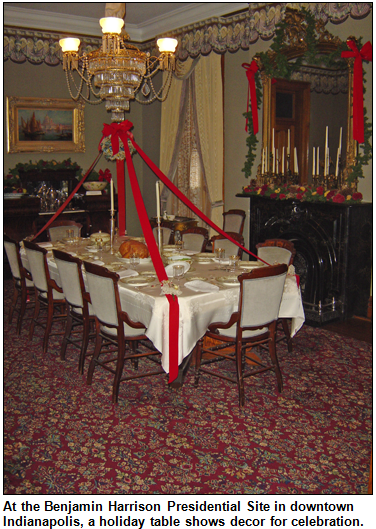 By the late 1880s, when the Harrisons moved into the White House, decorations on holiday trees often included wooden soldiers, cotton batting ornaments and hand-blown glass figures.
By the late 1880s, when the Harrisons moved into the White House, decorations on holiday trees often included wooden soldiers, cotton batting ornaments and hand-blown glass figures.
The Harrisons' children, Russell and Mary, were in their 30s during the family's White House years. Mary's young children (Benjamin and Caroline's grandchildren) even kept a pet goat in the stables at the White House.
The Christmas tree for 1889 in the White House was described as "a large, gorgeous tree trimmed by the president, his family and staff," according to Jennifer. "It carried toys not only for the children of the family, but for everyone attached to the White House and their families."
Sadly, Caroline Scott Harrison did not live to see the yuletide season of 1892, her husband's final year as president. She died in the White House of tuberculosis. (Thousands of Indianapolis residents watched the First Lady's funeral procession to Crown Hill Cemetery.) Two weeks after he lost his wife, Benjamin Harrison lost his bid for re-election.
Then he returned to live at the home on North Delaware Street in Indianapolis. Four years later, he married his second wife, Mary. They had a daughter, Elizabeth, who was born when her father was 63 years old. She had celebrated four yuletide seasons with her father when he died in 1901.
Upcoming events include:
- On Saturday (Dec. 10), the same day Jennifer will join Nelson in studio, the Harrison Home will offer special Christmas tours (with re-enactors of the 1888 season) designed for families. The tours will be from 10 a.m. to 3 p.m.
- The Harrison Home will be among five historic mansions included in "A Candlelight Evening on Delaware Street," a progressive walking tour on Dec. 28.
Roadtrip: The NFL Experience at Indiana Convention Center
 Does everyone know that our Roadtripper, Chris Gahl of the ICVA, is our own "insider's guru" for all the news about that big game coming to Indy in February? Chris will give us the latest updates on The NFL Experience, the pro football interactive theme park for young and old alike that will be taking over the Indiana Convention Center and Lucas Oil Stadium on Jan. 27 at 3 p.m.!
Does everyone know that our Roadtripper, Chris Gahl of the ICVA, is our own "insider's guru" for all the news about that big game coming to Indy in February? Chris will give us the latest updates on The NFL Experience, the pro football interactive theme park for young and old alike that will be taking over the Indiana Convention Center and Lucas Oil Stadium on Jan. 27 at 3 p.m.!
The action will include participatory games, displays, entertainment attractions, kids' football clinics, free autograph sessions and the largest football memorabilia show ever.
After its Jan. 27 opening, The NFL Experience will run daily from 10 a.m. to 10 p.m. through Feb. 4. Tickets are $25 for adults and $20 for children under 12.
History Mystery
An outdoor symbol of the yuletide season in downtown Indianapolis made its first appearance in 1947.  The whimsical symbol, which appeared on Thanksgiving Eve, was noticed by thousands of holiday shoppers during the next month, becoming instantly popular. It has been a fixture ever since, except for a brief period in the early 1990s.
The whimsical symbol, which appeared on Thanksgiving Eve, was noticed by thousands of holiday shoppers during the next month, becoming instantly popular. It has been a fixture ever since, except for a brief period in the early 1990s.
Question: Name this seasonal symbol in downtown Indy that made its debut in 1947.
Hint: It is not the decorated Soldiers and Sailors Monument, which became known as the "World's Largest Christmas Tree." The decorative lighting of the monument - during an event now called "The Celebration of Lights" - did not begin until 1962.
To win the prize, you must call in with the correct answer during the live show. Please do not call if you have won a prize from any WICR show during the last two months. The call-in number is (317) 788-3314, and please do not call until you hear Nelson pose the question on the air.
The prize is an overnight stay at the Westin Indianapolis, including valet parking and Shula's buffet breakfast, as well as two tickets to the Indiana State Museum. These prizes are courtesy of the ICVA.
Your Hoosier History Live! team,
Nelson Price, host and creative director
Molly Head, producer, (317) 927-9101
Chris Gahl, Roadtripper
Richard Sullivan, webmaster and tech director
Pam Fraizer, graphic designer
Garry Chilluffo, creative consultant
Michele Goodrich, Jed Duvall, grant consultants
www.hoosierhistorylive.org


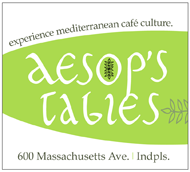


Please tell our sponsors that you appreciate their support: Aesop's Tables, Fadely College Counseling, Indiana Historical Society, Lucas Oil and Story Inn.
 Acknowledgments to Print Resources, Indianapolis Marion County Public Library, Monomedia, Indiana Humanities, Indianapolis Convention & Visitors Association, WICR-FM, Fraizer Designs, Heritage Photo and Research Services, Derrick Lowhorn, Samantha Stratton and many other individuals and organizations. We are an independently produced program and are self-supporting through organizational sponsorships, grants and through individual tax-deductible contributions through the Indiana Humanities Council. Visit our website to learn how you can support us financially.
Acknowledgments to Print Resources, Indianapolis Marion County Public Library, Monomedia, Indiana Humanities, Indianapolis Convention & Visitors Association, WICR-FM, Fraizer Designs, Heritage Photo and Research Services, Derrick Lowhorn, Samantha Stratton and many other individuals and organizations. We are an independently produced program and are self-supporting through organizational sponsorships, grants and through individual tax-deductible contributions through the Indiana Humanities Council. Visit our website to learn how you can support us financially.
Year-end support!
Keeping Hoosier History Live! alive
"What a fun and interesting way to learn about the heart and soul of our state. No boring class or books at Hoosier History Live!"
-
Judy O'Bannon, Indianapolis, former Indiana First Lady and producer of public television's Judy O’Bannon's Foreign Exchange
"As historical writers, we try to overcome the public's indifference to history, and to bring alive the important lessons of the past. 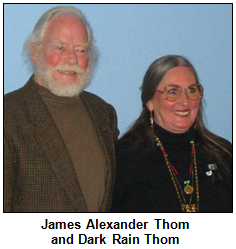 Hoosier History Live! does this so well that we hope to see it broadcast far and wide over this historically significant state of Indiana."
Hoosier History Live! does this so well that we hope to see it broadcast far and wide over this historically significant state of Indiana."
- James Alexander Thom and Dark Rain Thom, Bloomington, Indiana, authors
If you would like to make an individual tax deductible donation by the end of 2011, write out a check to "Indiana Humanities" and mention "to benefit Hoosier History Live!" in the memo line of the check.
The check may be mailed to:
Indiana Humanities
Attn: Nancy Conner
1500 N. Delaware St.
Indianapolis, IN 46202
Be sure to include your name and return address so that you can receive a tax donation receipt from Indiana Humanities. Remember that you also can memorialize a loved one with your donation.
Dec. 17 show
Inter-church history in Indy
Nearly 100 years ago, about 40 congregations gathered in downtown Indianapolis. Worried about gambling, alcohol trafficking and prostitution in 1912, the congregations formed one of the country's first church federations.
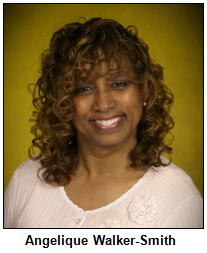 In the beginning, black churches could not join the Church Federation of Greater Indianapolis. As the organization prepares to celebrate its centennial in 2012, its executive director is Rev. Angelique Walker-Smith, the first African-American and the first woman to serve in the top post.
In the beginning, black churches could not join the Church Federation of Greater Indianapolis. As the organization prepares to celebrate its centennial in 2012, its executive director is Rev. Angelique Walker-Smith, the first African-American and the first woman to serve in the top post.
To share insights about the history of the church federation - which has evolved from being an exclusively white and Protestant organization to one that includes Catholics, blacks and an array of other ethnic groups - Angelique will join Nelson in studio.
So will Marion County historian David Vanderstel; he's working on a history of the church federation, which by the 1920s was opposing the Ku Klux Klan's sway over city and state officials. The federation inspired other church councils across the nation and helped fund the launch of Gleaners Food Bank of Indiana. During the 1940s, the Indy church federation fought racial discrimination at the U.S. Defense Department.
Throughout 2012, several events will mark the centennial, including a "Week of Prayer for Christian Unity" series from Jan. 16-21; speakers will include Rev. Boniface Hardin and former Mayor William Hudnut.
Some fun facts:
- In 1912, the church federation was alarmed by a decline in public morality that included "automobile speed contests." A morals committee investigated the one-year-old Indianapolis 500.
- Angelique, who has lived in three African countries, is a graduate of Yale Divinity School.
- David, who also is the development director at Martin University, was our studio guest in March for a show about the Irish in Indiana.
Hoosier History Live! events
Mark your calendar for Feb. 16!
Mark your calendar for the Hoosier History Live! 4th anniversary party on Thursday, Feb. 16 from 5 to 8 p.m. at Morris-Butler House. Again, courtesy of Indiana Landmarks.
Also ... the Irvington Library Hoosier History Live! Radio Club continues to be "a weekly thing." The listening group meets weekly in the Story Theater of the Irvington Library, 5625 E. Washington St., at 11:30 a.m. on Saturdays.
And remember: You can "like" the Hoosier History Live! Facebook page and make comments about topics and shows, as well, on the page.
© 2011 Hoosier History Live! All rights reserved.